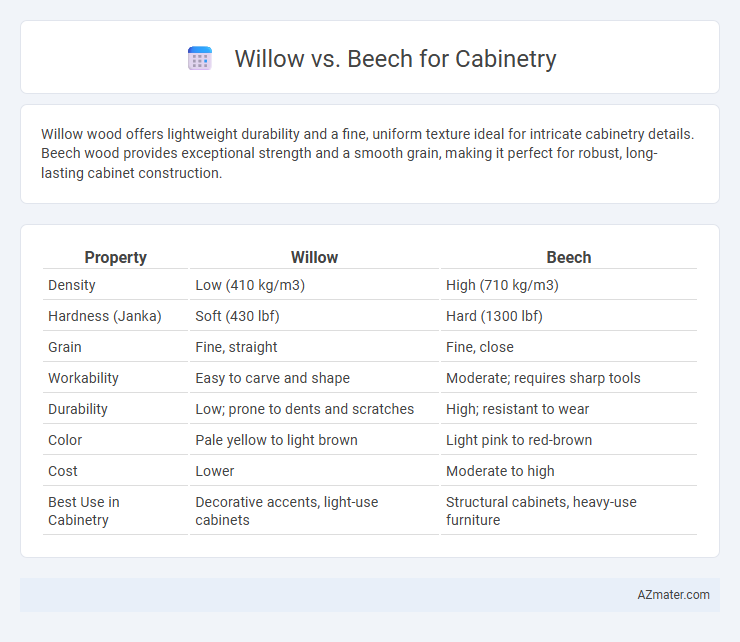Willow wood offers lightweight durability and a fine, uniform texture ideal for intricate cabinetry details. Beech wood provides exceptional strength and a smooth grain, making it perfect for robust, long-lasting cabinet construction.
Table of Comparison
| Property | Willow | Beech |
|---|---|---|
| Density | Low (410 kg/m3) | High (710 kg/m3) |
| Hardness (Janka) | Soft (430 lbf) | Hard (1300 lbf) |
| Grain | Fine, straight | Fine, close |
| Workability | Easy to carve and shape | Moderate; requires sharp tools |
| Durability | Low; prone to dents and scratches | High; resistant to wear |
| Color | Pale yellow to light brown | Light pink to red-brown |
| Cost | Lower | Moderate to high |
| Best Use in Cabinetry | Decorative accents, light-use cabinets | Structural cabinets, heavy-use furniture |
Willow vs Beech: An Overview for Cabinetry
Willow wood offers a lightweight, flexible option for cabinetry with a fine grain and pale color that suits modern design, while Beech wood is known for its durability, tight grain, and warm tone, making it ideal for traditional, sturdy cabinets. Beech's resistance to wear and ability to take stains evenly contrast with Willow's softer texture, which may be more prone to dents but easier to carve for decorative finishes. Choosing between Willow and Beech depends on whether the priority is durability and classic aesthetics or lightweight design with intricate detailing potential.
Wood Density: Comparing Willow and Beech
Willow wood has a low density, typically around 320 kg/m3, making it lightweight but less durable for cabinetry. Beech wood, with a higher density of approximately 720 kg/m3, offers enhanced strength and resistance to wear, ideal for long-lasting cabinetry. The substantial difference in wood density impacts the cabinetry's durability, stability, and ability to hold hardware effectively.
Grain Patterns and Aesthetic Appeal
Willow wood features a subtle, straight grain with occasional wavy patterns, offering a soft, rustic aesthetic that fits well in casual or country-style cabinetry. Beech wood exhibits a tight, consistent grain with a fine texture, creating a smooth and modern appearance ideal for contemporary kitchen designs. Both woods provide durability, but Beech's uniform grain enhances its ability to take stains evenly, yielding a more polished finish compared to the natural, organic look of Willow.
Durability and Strength in Cabinet Applications
Willow wood is softer and less dense than beech, making it less durable and more prone to dents and scratches in cabinetry applications. Beech wood offers superior strength and hardness, providing excellent resistance to wear, impact, and deformation, ideal for high-traffic cabinet areas. For cabinetry requiring long-lasting durability and structural integrity, beech is the preferred choice over willow.
Workability: Cutting, Shaping, and Finishing
Willow wood offers excellent workability due to its soft texture, allowing for easy cutting, shaping, and smooth finishing ideal for detailed cabinetry. Beech, while harder and denser, provides a stable surface that holds intricate cuts well and finishes with a fine, uniform grain, making it durable for high-quality cabinetry applications. The choice between willow and beech depends on the desired balance of ease in craftsmanship and longevity of the cabinet surfaces.
Cost Comparison: Willow vs Beech Cabinets
Willow cabinets generally cost less than beech cabinets due to the faster growth rate and wider availability of willow wood, making it a budget-friendly option for cabinetry. Beech cabinets tend to be more expensive because beech wood is denser and harder, offering superior durability and a finer grain that enhances cabinet aesthetics. Choosing between willow and beech for cabinetry involves balancing cost with desired strength and appearance, with willow offering affordability and beech providing premium quality.
Sustainability and Sourcing Considerations
Willow wood offers rapid growth and renewability, making it a sustainable choice for cabinetry compared to slow-growing beech, which requires long-term forest management. Beech is typically sourced from temperate regions with established forestry certifications like FSC, ensuring responsible harvesting, while willow is often farmed in short rotation coppices that minimize environmental impact. Choosing willow reduces carbon footprint due to faster regrowth cycles, whereas beech's durability supports longevity but depends on sustainable sourcing to mitigate deforestation risks.
Moisture Resistance and Stability
Willow wood offers moderate moisture resistance but is generally less stable than beech, making it more prone to warping in humid environments. Beech is highly valued for cabinetry due to its superior dimensional stability and better moisture resistance, ensuring longevity and durability in varying conditions. The dense grain structure of beech minimizes swelling and shrinkage, which is crucial for maintaining cabinet integrity over time.
Best Uses: Willow and Beech in Kitchen Design
Willow wood offers a unique, rustic texture and lightweight durability ideal for cabinet fronts that aim for a cozy, farmhouse kitchen aesthetic. Beech wood is dense, hard, and smooth, making it perfect for kitchen cabinetry requiring high durability and a sleek, modern appearance. Combining willow's warm tones with beech's strength supports both stylistic versatility and functional longevity in kitchen design.
Choosing the Right Wood: Willow or Beech for Your Cabinets
Willow offers a lightweight and fine-grained texture with a natural pale hue, making it ideal for contemporary cabinetry requiring subtle elegance and ease of sanding. Beech provides a harder, dense structure with a warm reddish-brown tone, excellent for durable and richly finished cabinets that withstand daily use. Selecting the right wood hinges on balancing desired aesthetic appeal, durability needs, and finishing preferences to achieve cabinetry that complements your space and functional demands.

Infographic: Willow vs Beech for Cabinetry
 azmater.com
azmater.com